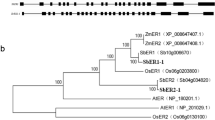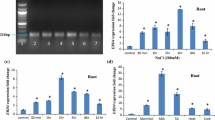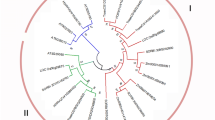Abstract
Lepidium latifolium L., a weed distributed in the Ladakh region of Himalayan range, belongs to Brassicaceae family and reported to withstand low temperature stress <−20 °C. RACE primers were designed from EST encoding Ras-related GTP-binding like protein (FG618354) from L. latifolium and full-length LlaRan (GU014818) was obtained. Its cDNA sequence consisted of 672 bp long open-reading frame, 5′ UTR of 95 bp and 3′ UTR of 115 bp, respectively. The predicted Lepidium RAN protein encodes a 223 aa protein of 25.59 kDa and pI 6.08. In silico characterization of LlaRan suggested that it has a universal RAN domain across species and likely to follow similar functions. Transcript accumulation studies in response to cold stress suggested that it is an early downregulated gene but a late upregulated gene. Quantitative analysis using real-time PCR revealed differential regulation of the transcript not only under cold stress but also under the effect of stress regulators like jasmonic acid, salicylic acid, calcium, abscisic acid and ethylene which suggests a possible crosstalk between different pathways where LlaRan may have an important role to play. Thus, LlaRan is a candidate gene for engineering plants against abiotic stresses after its further functional validation in model plants.




Similar content being viewed by others
References
Altschul SF, Madden TL, Schäffer AA, Zhang J, Zhang Z, Miller W, Lipman DJ (1997) Gapped BLAST and PSI-BLAST: a new generation of protein database search programs. Nucleic Acids Res 25(17):3389–3402
Aslam M, Sinha VB, Singh RK, Anandhan S, Pande V, Ahmed Z (2010) Isolation of cold stress responsive genes from Lepidium latifolium by suppressive subtraction hybridization. Acta Physiol Plant 32(1):205–210
Aslam M, Grover A, Sinha VB, Fakher B, Pande V, Yadav PV, Gupta SM, Anandhan S, Ahmed Z (2012) Isolation and characterization of cold responsive NAC gene from Lepidium latifolium. Mol Biol Rep 39(10):9629–9638
Bailey TL, Williams N, Misleh C, Li WW (2006) MEME: discovering and analyzing DNA and protein sequence motifs. Nucleic Acids Research 34 (Web Server):W369–W373
Bischoff F, Molendijk A, Rajendrakumar C, Palme K (1999) GTP-binding proteins in plants. Cell Mol Life Sci CMLS 55(2):233–256
Bourne HR, Sanders DA, McCormick F (1991) The GTPase superfamily: conserved structure and molecular mechanism. Nature 349:117–127
Ciciarello M, Mangiacasale R, Lavia P (2007) Spatial control of mitosis by the GTPase Ran. Cell Mol Life Sci 64(15):1891–1914
de Ollas C, Hernando B, Arbona V, Gómez-Cadenas A (2013) Jasmonic acid transient accumulation is needed for abscisic acid increase in citrus roots under drought stress conditions. Physiol Plant 147(3):296–306
Dereeper A, Guignon V, Blanc G, Audic S, Buffet S, Chevenet F, Dufayard J-F, Guindon S, Lefort V, Lescot M (2008) Phylogeny. fr: robust phylogenetic analysis for the non-specialist. Nucleic Acids Res 36(suppl 2):W465–W469
Doyle JJ, Doyle JL (1990) Isolation of plant DNA from fresh tissue. Focus 12:13–15
Ghassemian M, Nambara E, Cutler S, Kawaide H, Kamiya Y, McCourt P (2000) Regulation of abscisic acid signaling by the ethylene response pathway in Arabidopsis. Plant Cell Online 12(7):1117–1126
Görlich D, Kutay U (1999) Transport between the cell nucleus and the cytoplasm. Annu Rev Cell Dev Biol 15(1):607–660
Guo Y, Halfter U, Ishitani M, Zhu J-K (2001) Molecular characterization of functional domains in the protein kinase SOS2 that is required for plant salt tolerance. Plant Cell Online 13(6):1383–1400
Hall A (1990) The cellular functions of small GTP-binding proteins. Science 249(4969):635–640
Hewezi T, Léger M, El Kayal W, Gentzbittel L (2006) Transcriptional profiling of sunflower plants growing under low temperatures reveals an extensive down-regulation of gene expression associated with chilling sensitivity. J Exp Bot 57(12):3109–3122
Higo K, Ugawa Y, Iwamoto M, Korenaga T (1999) Plant cis-acting regulatory DNA elements (PLACE) database: 1999. Nucleic Acids Res 27(1):297–300
Kaur G, Kumar S, Nayyar H, Upadhyaya H (2008) Cold stress injury during the pod-filling phase in chickpea (Cicer arietinum L.): effects on quantitative and qualitative components of seeds. J Agron Crop Sci 194(6):457–464
Kim S-H, Roux SJ (2003) An Arabidopsis ran binding protein, AtRanBP1c, is a co-activator of ran GTPase-activating protein and requires the C-terminus for its cytoplasmic localization. Planta 216(6):1047–1052
Kumar S, Malik J, Thakur P, Kaistha S, Sharma KD, Upadhyaya H, Berger J, Nayyar H (2011) Growth and metabolic responses of contrasting chickpea (Cicer arietinum L.) genotypes to chilling stress at reproductive phase. Acta Physiol Plant 33(3):779–787
Mizoi J, Shinozaki K, Yamaguchi-Shinozaki K (2012) AP2/ERF family transcription factors in plant abiotic stress responses. Biochim Biophys Acta (BBA) Gene Regul Mech 1819(2):86–96
Ohnishi S, Miyoshi T, Shirai S (2010) Low temperature stress at different flower developmental stages affects pollen development, pollination, and pod set in soybean. Environ Exp Bot 69(1):56–62
Pfaffl MW, Horgan GW, Dempfle L (2002) Relative expression software tool (REST©) for group-wise comparison and statistical analysis of relative expression results in real-time PCR. Nucleic Acids Res 30(9): e36–e36
Pruitt KD, Tatusova T, Maglott DR (2007) NCBI reference sequences (RefSeq): a curated non-redundant sequence database of genomes, transcripts and proteins. Nucleic Acids Res 35(suppl 1):D61–D65
Rhee SY, Beavis W, Berardini TZ, Chen G, Dixon D, Doyle A, Garcia-Hernandez M, Huala E, Lander G, Montoya M (2003) The Arabidopsis information resource (TAIR): a model organism database providing a centralized, curated gateway to Arabidopsis biology, research materials and community. Nucleic Acids Res 31(1):224–228
Ristic Z, Ashworth E (1993) Changes in leaf ultrastructure and carbohydrates in Arabidopsis thaliana L. (Heyn) cv. Columbia during rapid cold acclimation. Protoplasma 172(2–4):111–123
Rymen B, Fiorani F, Kartal F, Vandepoele K, Inzé D, Beemster GT (2007) Cold nights impair leaf growth and cell cycle progression in maize through transcriptional changes of cell cycle genes. Plant Physiol 143(3):1429–1438
Sambrook J, Fritsch EF, Maniatis T (1989) Molecular cloning, vol 2. Cold spring harbor laboratory press, New York
Sinha VB, Grover A, Ahmed Z, Pande V (2014) Isolation and functional characterization of DNA damage repair protein (DRT) from Lepidium latifolium L. Comptes Rendus Biol 337(5):302–310
Sowiński P, Rudzińska-Langwald A, Adamczyk J, Kubica I, Fronk J (2005) Recovery of maize seedling growth, development and photosynthetic efficiency after initial growth at low temperature. J Plant Physiol 162(1):67–80
Stormo GD (2000) Gene-finding approaches for eukaryotes. Genome Res 10(4):394–397
Suzuki K, Nagasuga K, Okada M (2008) The chilling injury induced by high root temperature in the leaves of rice seedlings. Plant Cell Physiol 49(3):433–442
Takai Y, Sasaki T, Matozaki T (2001) Small GTP binding proteins. Physiol Rev 81(1):153–208
Thompson JD, Higgins DG, Gibson TJ (1994) CLUSTAL W: improving the sensitivity of progressive multiple sequence alignment through sequence weighting, position-specific gap penalties and weight matrix choice. Nucleic Acids Res 22(22):4673–4680
Uemura M, Joseph RA, Steponkus PL (1995) Cold acclimation of Arabidopsis thaliana (effect on plasma membrane lipid composition and freeze-induced lesions). Plant Physiol 109(1):15–30
Untergasser A, Nijveen H, Rao X, Bisseling T, Geurts R, Leunissen JA (2007) Primer3Plus, an enhanced web interface to Primer3. Nucleic Acids Res 35(suppl 2):W71–W74
Wang X, Xu Y, Han Y, Bao S, Du J, Yuan M, Xu Z, Chong K (2006) Overexpression of RAN1 in rice and Arabidopsis alters primordial meristem, mitotic progress, and sensitivity to auxin. Plant Physiol 140(1):91–101
Yoshida R, Kanno A, Kameya T (1996) Cool temperature-induced chlorosis in rice plants (II. effects of cool temperature on the expression of plastid-encoded genes during shoot growth in darkness). Plant Physiol 112(2):585–590
Zang A, Xu X, Neill S, Cai W (2010) Overexpression of OsRAN2 in rice and Arabidopsis renders transgenic plants hypersensitive to salinity and osmotic stress. J Exp Bot 61(3):777–789. doi:10.1093/jxb/erp341
Zheng Z-L, Yang Z (2000) The Rop GTPase: an emerging signaling switch in plants. Plant Mol Biol 44(1):1–9
Acknowledgments
Financial support to Vimlendu Bhushan Sinha and Mohammad Aslam by Defence Research Development organization (DRDO), India, is duly acknowledged. Authors also thank Defence Institute of High altitude Research (DIHAR), Leh, India, for their help in collection of the plant material.
Conflict of interest
Authors declare no conflict of interest.
Author information
Authors and Affiliations
Corresponding author
Additional information
Communicated by M. Hajduch.
Rights and permissions
About this article
Cite this article
Sinha, V.B., Grover, A., Aslam, M. et al. Isolation and characterization of Ras-related GTP-binding protein (Ran) from Lepidium latifolium L. reveals its potential role in regulating abiotic stress tolerance. Acta Physiol Plant 36, 2353–2360 (2014). https://doi.org/10.1007/s11738-014-1608-7
Received:
Revised:
Accepted:
Published:
Issue Date:
DOI: https://doi.org/10.1007/s11738-014-1608-7




